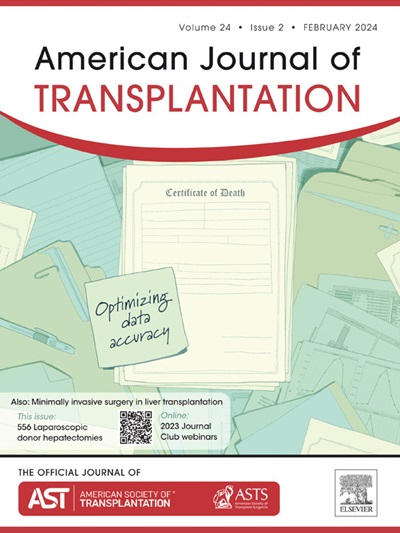Subthreshold rejection activity in many kidney transplants currently classified as having no rejection
IF 8.9
2区 医学
Q1 SURGERY
引用次数: 0
Abstract
Most kidney transplant patients who undergo biopsies are classified as having no rejection based on consensus thresholds. However, we hypothesized that because these patients have normal adaptive immune systems, T cell–mediated rejection (TCMR) and antibody-mediated rejection (ABMR) may exist as subthreshold activity in some transplants currently classified as no rejection. To examine this question, we studied genome-wide microarray results from 5086 kidney transplant biopsies (from 4170 patients). An updated molecular archetypal analysis designated 56% of biopsies as no rejection. Subthreshold molecular TCMR and/or ABMR activity molecular activity was detectable as elevated classifier scores in many biopsies classified as no rejection, with ABMR activity in many TCMR biopsies and TCMR activity in many ABMR biopsies. In biopsies classified as no rejection histologically and molecularly, molecular TCMR classifier scores correlated with increases in histologic TCMR features and molecular injury, lower estimated glomerular filtration rate, and higher risk of graft loss, and molecular ABMR activity correlated with increased glomerulitis and donor-specific antibody. No rejection biopsies with high subthreshold TCMR or ABMR activity had a higher probability of having TCMR or ABMR, respectively, diagnosed in a future biopsy. We conclude that many kidney transplant recipients have unrecognized subthreshold TCMR or ABMR activity, with significant implications for future problems.
目前被归类为无排斥反应的许多肾移植中都存在阈值以下的排斥反应活动。
根据共识阈值,大多数接受活检的肾移植患者被归类为无排斥反应。然而,我们假设,由于这些患者的适应性免疫系统正常,T 细胞介导的排斥反应(TCMR)和抗体介导的排斥反应(ABMR)可能作为阈值下的活动存在于目前被归类为无排斥反应的一些移植中。为了研究这个问题,我们研究了 5086 例肾移植活检(4170 名患者)的全基因组芯片结果。最新的原型分析将 56% 的活检结果定为无排斥反应。在许多被归类为无排斥反应的活检中,可检测到阈值以下的TCMR和/或ABMR分子活性,表现为分类器评分升高,许多TCMR活检中有ABMR活性,许多ABMR活检中有TCMR活性。在组织学和分子学分类为无排斥反应的活检中,分子 TCMR 分类器评分与组织学 TCMR 特征和分子损伤的增加、较低的 eGFR 和较高的移植物丢失风险相关,而分子 ABMR 活性与肾小球炎和供体特异性抗体的增加相关。阈值以下TCMR或ABMR活性较高的无排斥活检在未来的活检中被诊断为TCMR或ABMR的概率较高。我们的结论是,许多肾移植受者存在未被发现的阈值下 TCMR 或 ABMR 活性,这对未来的问题具有重大影响。
本文章由计算机程序翻译,如有差异,请以英文原文为准。
求助全文
约1分钟内获得全文
求助全文
来源期刊
CiteScore
18.70
自引率
4.50%
发文量
346
审稿时长
26 days
期刊介绍:
The American Journal of Transplantation is a leading journal in the field of transplantation. It serves as a forum for debate and reassessment, an agent of change, and a major platform for promoting understanding, improving results, and advancing science. Published monthly, it provides an essential resource for researchers and clinicians worldwide.
The journal publishes original articles, case reports, invited reviews, letters to the editor, critical reviews, news features, consensus documents, and guidelines over 12 issues a year. It covers all major subject areas in transplantation, including thoracic (heart, lung), abdominal (kidney, liver, pancreas, islets), tissue and stem cell transplantation, organ and tissue donation and preservation, tissue injury, repair, inflammation, and aging, histocompatibility, drugs and pharmacology, graft survival, and prevention of graft dysfunction and failure. It also explores ethical and social issues in the field.

 求助内容:
求助内容: 应助结果提醒方式:
应助结果提醒方式:


